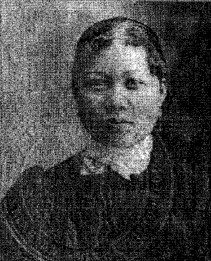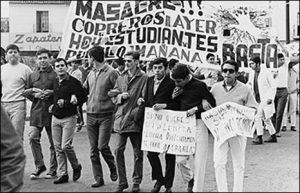In 1899, Ah Sou, a Chinese orphan, was sold to a man named Moy Sam with the belief that she would accompany him to the United States of America to become his daughter. There are no records indicating why or how she was sold. After her trip across the Pacific Ocean, she landed at Port Townsend, Washington, on August 23, 1900, and discovered that she would be forced into prostitution.1 Despite learning this, she followed the orders she was given, and told immigration inspectors at the entry port that Moy Sam was her father and a merchant.

After enduring three years of abuse from Moy Sam, she overheard that she was about to be sold to another man for further exploitation. She decided that she needed to act fast before being sold, and found a way to escape in November of 1903 to The Home for Chinese Women and Girls. Reverend William Holt and his wife, Frances Holt, unintentionally founded the home in Portland, Oregon after serving as American missionaries in China. It began with one Chinese woman who sought refuge with Reverend and Mrs. Holt; not long after, more women followed her lead. Eventually, the home, located at 350 Fourteenth Street, was opened in April 1889.2
There was a Board of Directors of the Home in Portland, which gave it a certain degree of legitimacy. The home taught the women how to speak English, as well as how to read English and Chinese. They were educated in various skills, such as housework, needle-work, and Bible studies. Mrs. Holt said, “They eat Chinese food, wear Chinese clothes, except the shoes, have very plain furniture in their rooms, and are led to look forward to such lives as respectable, intelligent Chinese women may hope to enjoy. The purpose is not to make them over into American women, which might end in dissatisfaction and unhappiness by and by, but we want them to develop into good, useful Chinese women.”3 The home was such a success that a deaf-mute girl, who was raised there, gave a speech at a board meeting, gesturing, “More love to thee.”4

While Ah Sou was at the home, she was the only girl there, which made the days long and boring for her. While she was there, she was married by Reverend Holt to a Chinese man named Lum Kong, because they believed that he was a Chinese merchant. That was important, because being married to a Chinese merchant meant that Ah Sou would be able to legally stay in America. After a number of weeks, Ah Sou made it very clear that she wanted to leave the home, because being the only girl there made her feel very lonely. Frances Holt and the staff did not like the idea of her leaving. Mrs. Holt said, “We wished [Ah Sou] to stay, we did everything we could to persuade her to stay, we hoped she would stay with us for a year or more and it was [Lum Kong’s] wish that she stay, but she said she did not want to, she preferred to leave.”5 Although Lum Kong wanted Ah Sou to stay, he did nothing to keep her from leaving because their marriage did not mean much to him. He knew that the sole reason for their marriage was to try to legalize her status in the United States.
After she left the home, Ah Sou traveled to Seattle where she ran into Moy Sam, who was cooperating with law enforcement to have her arrested. On January 1, 1904, she was arrested by an immigration inspector, and on January 8, 1904, Commissioner James Kiefer ordered her to be deported to China. In between her apprehension and the deportation order, there was a lengthy hearing at which a number of witnesses testified. These witnesses included: the immigration inspectors who arrested and interviewed Ah Sou, a baggageman for the Northern Pacific Railroad who knew Moy Sam, the photographer who helped Moy Sam create a fake family photograph, Mrs. Holt, the employer of Lum Kong, and Lum Kong. When Ah Sou was asked about her time with Moy Sam she said, “I was whipped and beaten by [Moy Sam]. Every day I was beaten by him with sticks of wood until I was black and blue.”6 She also informed the court that she never received any of her earnings during her time with Moy Sam. At the end of the hearing, it was decided that the only reason for Ah Sou’s marriage was so that she would not be deported, thus making her deportable. She was seen as nothing more than an illegal immigrant turned prostitute. However, Ah Sou refused to give up and appealed the deportation order to the United States District Court for the District of Washington, where Judge Cornelius Hanford presided over her appeal.

Although Judge Hanford’s further investigation led him to find out that Lum Kong was not actually a merchant, and he agreed that Ah Sou’s marriage was not bona fide, he still decided to reverse the deportation order. Judge Hanford stated, “The laws excluding Chinese immigrants and women imported for immoral purposes require the court to cause a person in the situation of the appellant to be deported to China. Compliance with the statute in this case will be, in my estimation, a barbarous proceeding, for it will be equivalent to remanding the appellant to perpetual slavery and degradation.”7 He also emphasized Ah Sou’s great effort to escape Moy Sam and create a life for herself. He stressed that the Thirteenth Amendment prohibits slavery and that the only way she could be emancipated was if she was released from custody and allowed to remain in America. Unfortunately, the government appealed Judge Hanford’s decision to the United States Court of Appeals for the Ninth Circuit.
Ah Sou argued that the court did not have any right to her case, and said, “[The] sole question involved is the application of the thirteenth amendment to the Constitution of the United States, and that therefore the appellate jurisdiction of the Supreme Court is exclusive.” However, the Judiciary Act of 1891 gave the Supreme Court exclusive jurisdiction over “the construction or application of the Constitution of the United States.”8 This court ruled, “We see no escape from the conclusion that the judgment of the trial court must be reversed, and the appellee remanded to the country whence she came.”9 Ah Sou tried appealing this ruling to the Supreme Court, but her appeal was denied for lack of jurisdiction. On March 8, 1906 Ah Sou was placed aboard a steamer named “Manchuria,” and left San Francisco for Hong Kong, China. That is where her records end; nothing more was heard of Ah Sou.10
Unfortunately, there are many other stories just like Ah Sou’s, where young girls are sexually exploited and are seen as nothing more than illegal immigrants. More recently, the Trafficking Victims Protection Act of 2000 has been created to help persons trafficked and ensure that traffickers face adequate consequences. This act ensures that governments have recovery centers that provide medical treatments to heal the physical and mental abuse that victims endure. Yet there are still instances like Ah Sou’s that have holes and gaps in their journey that may never be discovered, as sex-trafficking victims are only provided minimal care so that some governments can say that they are doing their job to make sure the victims are accounted for.11
It is not shocking that a Chinese orphan was so easily tricked into being trafficked. Sex trafficking is still a global issue, but is especially prevalent in China. During China’s early years of economic liberalization, sex establishments were operated in the Special Economic Zones. These establishments catered to everyone–clients ranged from local businessmen to foreign investors. The sex-trafficking industry is so common in China, that every major city has a red-light district, which is where sex establishments congregate to make it easier for people to locate them.12 If you or anyone you know is being sex-trafficked or at risk, the National Human Trafficking Hotline is +1 (888) 373-7888. They have translators that speak over 200 language who are available 24/7. If you would like to send them a message, text “HELP” or “INFO” to 233733. For more information please visit https://humantraffickinghotline.org/.13
- Margaret McKeown and Emily Ryo, “The Lost Sanctuary: Examining Sex Trafficking Through the Lens of United States v. Ah Sou,” Cornell International Law Journal 41, no. 3 (2008): 748. ↵
- Margaret McKeown and Emily Ryo, “The Lost Sanctuary: Examining Sex Trafficking Through the Lens of United States v. Ah Sou,” Cornell International Law Journal 41, no. 3 (2008): 749. ↵
- Margaret McKeown and Emily Ryo, “The Lost Sanctuary: Examining Sex Trafficking Through the Lens of United States v. Ah Sou,” Cornell International Law Journal 41, no. 3 (2008): 750. ↵
- David Livingstone, “What Japanese Christian Women are Doing for Korea,” Woman’s Work 48, no. 3 (1913): 165. ↵
- Margaret McKeown and Emily Ryo, “The Lost Sanctuary: Examining Sex Trafficking Through the Lens of United States v. Ah Sou,” Cornell International Law Journal 41, no. 3 (2008): 751. ↵
- Margaret McKeown and Emily Ryo, “The Lost Sanctuary: Examining Sex Trafficking Through the Lens of United States v. Ah Sou,” Cornell International Law Journal 41, no. 3 (2008): 749. ↵
- Margaret McKeown and Emily Ryo, “The Lost Sanctuary: Examining Sex Trafficking Through the Lens of United States v. Ah Sou,” Cornell International Law Journal 41, no. 3 (2008): 753. ↵
- Margaret McKeown and Emily Ryo, “The Lost Sanctuary: Examining Sex Trafficking Through the Lens of United States v. Ah Sou,” Cornell International Law Journal 41, no. 3 (2008): 754-755. ↵
- Margaret McKeown and Emily Ryo, “The Lost Sanctuary: Examining Sex Trafficking Through the Lens of United States v. Ah Sou,” Cornell International Law Journal 41, no. 3 (2008): 755. ↵
- Margaret McKeown and Emily Ryo, “The Lost Sanctuary: Examining Sex Trafficking Through the Lens of United States v. Ah Sou,” Cornell International Law Journal 41, no. 3 (2008): 755. ↵
- “2018 Trafficking in Persons Report” (Department of State, June 2018), 4,39 https://www.state.gov/documents/organization/282798.pdf. ↵
- Bonny Ling, “Human Trafficking and China: Past and Present” (Thesis, National University of Ireland Galway, 2014), http://hdl.handle.net/10379/4730. ↵
- “National Human Trafficking Hotline,” National Human Trafficking Hotline, accessed April 6, 2019, https://humantraffickinghotline.org/node. ↵



55 comments
Micheala Whitfield
Great article! Even though her records end at the steamer, I’m glad there was an opportunity for her story to be told. I wonder why you chose this specific women? I had no idea there are red light districts in China’s major cities. I would have thought it was an Amsterdam vibe. Sex trafficking runs so deep through out the world. Individuals pray on these innocent women and sometimes boys that they know could not be protected by any jurisdiction. What’s sad is to see that at that time and sometimes to this era, if it comes down to the fact the person is an immigrate, what is done to them does not matter and it’s swept under the rug. I do hope that one day the justice system world wide, protects innocent people being forced into trafficking and they are educated at a young age on how to reach out for help.
Sara Guerrero
Ah Sou had the courage to stand up for herself after the tramatic event she had gone through and sex traffacking has only gotten worse and it’s upsetting to live in a world where its currently going on. The outcome of her case is enraging because I see that no justice was really done in her part and outcomes like these make other victims afraid to speak up in the fear that no one would believe them. They have rights and they have the help we are so oblivious to what goes on and things like this could happen infront of you.
Sara Guerrero
It’s definitely upsetting to live in a world were issues like sex trafficing still exist today and being orphan having no one to look after you shows the corruption of the world Ah Sou being an innocent child no one deserved that kind of experience. The outcome of her case was definitely enraging because no justice was really done and outcomes like this make other victims afraid to stand up for themselves. They have the same rights as anyone and I’m glad she had the courage to speak up.
Raul Colunga
Such a sad story and one that continues to happen around the world. Ah Sou showed courage by taking on the judicial system to fight for her rights, but unfortunately the system failed her. It was nice to read that one of the judges gave her a fair shake but sadly he was not a judge in a higher position.
Ariana Melendez
Ah Sou was courageous and knew her rights to a certain extent. It is admirable the way she fought her case and even went up against the Supreme Court. However, I am not surprised with the outcome because time and time again victims do not get any justice. It is nice to see that the judge took Ah Sou’s side, but the outcome portrays that what the U.S. really cared about was getting rid of illegal immigrants rather than the sex trafficking epidemic.
Briana Montes
Overall, very well written article. It was so unbelievable to read how so many innocent people are abused and hurt. It is saddening that this issue is still around. Its is something that people still do and its so terrible. I hope that one day the US will take some type of action to put an end to this issue instead of focusing on other issues that are maybe less important and can be held back while this is getting taken care of.
Olivia Tijerina
I value the message that was bought up to the article when we are talking about an issue of awareness. And I have not yet run into something like this one but I now come to know that issues like these are relevant when we have illegal immigration today. But, the focus at hand was that a court had found a victim of sex trafficking that happened to be an illegal immigrant and the only action the court took was to depot Ah Sou. No other action to prevent or to help Ah Sou,the current, or future victims.
Rahni Hingoranee
This article is absolutely heartbreaking. Ah Sou simply wanted to achieve the American dream but instead was forced into acts that would take away her innocence. I was hoping for a happy ending to this article, but this is the sad reality that many people like her face. It’s disappointing, as well, to know that the courts at this time worked against her.
Bianca Villarreal
Reading this made me hope there was a happy ending, but once I got to the end I realized there’s rarely any happy endings when it comes to victims of sex trafficking or sexual assault in today’s times. I look at people like Cyntoia Brown, Chanel Miller, Christine Ford, and many other women and see that the assaulter always gets a slap on the hand and an easy trial. The victims never get the justice they deserve. Since forever, the U.S. government has been misogynistic and has favored white men, or just men in general, when it comes to women coming forward to report the assault against them. And then add that the victim is a minority or an immigrant makes it even worse for them.
Isabella Torres
This article was very well put together and the fact that Ah Sou was never head from again after being sent back to Hong Kong really shocked me.; it is crazy to me that the government didn’t do more for her considering her circumstances at the time. People do not always realize that sex trafficking can often become lifelong slavery both inside and outside the United States. I had never heard of Ah Sou until reading this article and I think it did a great job of not only telling her story, but explaining how prevalent sex trafficking still is today.